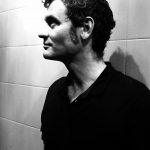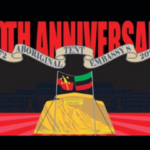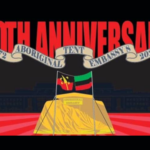Aboriginal Tent Embassy Sydney Is Raising the Unfinished Business of Sovereignty
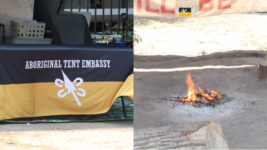
The sacred fire is once again burning at the Aboriginal Tent Embassy Sydney, which is located upon ancient songlines on Gadigal land in Isabel Coe Memorial Park, otherwise known as Camperdown’s Victoria Park, which backs onto Sydney University. And those maintaining the site are clear that there’s unfinished business in this country in respect of sovereignty.
The Aboriginal Tent Embassy Sydney, with its various iterations in 2000, 2002, 2004 and 2007, is coming up to its 25th anniversary next year. And the fire at the site was relit in January this year, and it’s continuing strong, with a view to the upcoming 26th of January Invasion Day rally.
Wiradjuri woman Isabel Coe was one of the founders of the Sydney embassy in 2000. She was married to Gomeroi man Billy Craigie, and he was one of the four men who launched the Aboriginal Tent Embassy on Ngunnawal Country in front of what’s now known as Old Parliament House in Canberra on 26 January 1972.
The three other founders of the original embassy were Ghillar Michael Anderson, Tony Coorey and Bertie Williams.
Gomeroi woman Gwenda Stanley was at the embassy this past week. She was there last January when Nioka Coe, currently the caretaker of the Aboriginal Tent Embassy in Canberra, once again lit the fire of the Aboriginal Tent Embassy Sydney, of which her mother Aunty Isabel Coe had done at the turn of the century.
And Stanley too is a caretaker at the original Aboriginal Tent Embassy, when she’s down in the capital.

“Ancient pathways of our ancestors”
“The significance of this area is it’s on the ancient pathways and the songlines: these are the original camp lines.” Stanley told Sydney Criminal Lawyers. “This was an area where our people would come and gather and camp, and trade with the coastal mob. If you looked at all this without all the buildings, you can see in each direction, which we go and flow.”
With the university behind it, the triangular park is bordered by Parramatta Road and City Road. And Stanley explained that those paved thoroughfares are “all ancient pathways that the Europeans built over”.
The Gomeroi woman further pointed out that across to the other side of the park, where Parramatta Road meets Glebe Point Road, there’s a marker belonging to the original British colony of Sydney, which signalled its border, and it meant First Peoples were not permitted to cross into it.
In regard to the original Aboriginal Tent Embassy, Stanley explained that the purpose of it was to bring together the “many different clan groups from around the country to be one political portal for our people right across.”
In terms of the Aboriginal Tent Embassy Sydney, Aunty Isabel and others founded it at the time of the Sydney Olympics and it sought to raise Aboriginal sovereignty and the genocide against the First People of this continent with the rest of the globe.
When Aunty Isabel was not at the Sydney site, she stayed at the Aboriginal Tent Embassy in Canberra, where she acted as a caretaker from 1992 until her passing in 2012. And Coe’s children and grandchildren continue there to this day.
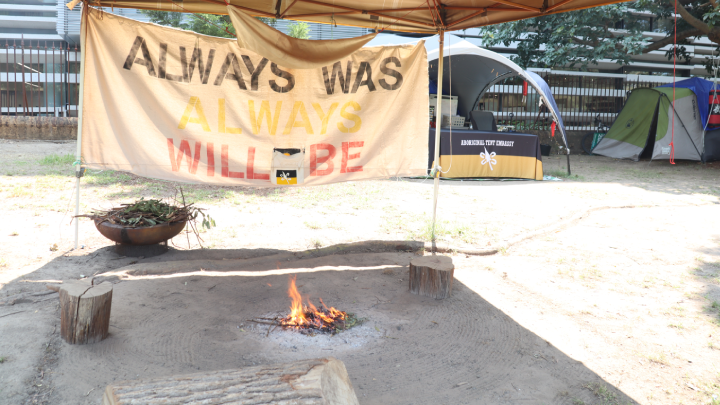
Sovereignty never ceded
The founding of the Aboriginal Tent Embassy was a direct response to then Australian PM Billy McMahon releasing a statement on 25 January 1972, announcing that he would not recognise land rights, but he would instead establish a lease system, whereby First Nations people could apply for 50 year leases to cover their own land.
After a community meeting in Sydney that same night, it was agreed that the four men, Craigie, Anderson, Coorey and Williams would immediately drive down to Canberra and establish what is today the longest running protest action on the planet, with this coming 26 January marking its 52nd anniversary.
Stanley was at the 40th anniversary gathering at the Aboriginal Tent Embassy and recalls that those present were given a mandate to go back out into their communities and start raising sovereignty and land rights and mobilising in response to them.
The uptick in street protests and media attention that’s been provided to Indigenous issues, such as celebrating the 26th of January and the ever-growing Invasion Day rallies ever since, are a direct result of this.
“The mandate was to go back and talk up sovereignty and reoccupy homeland,” Stanley recalled. “Wangan and Jagalingou has done that: Adrian Burragubba and Gurridiluya, his son, have been taking on Adani.”
“We established the embassy in Musgrave Park,” she continued. “Aunty Jenny had the embassy in Redfern. There was an embassy in Moree. There was one at Sandon Point. There were ones in South Australia and Western Australia.”
“So, there were political portals set up across the country.”

Unfinished business
The Aboriginal Tent Embassy Sydney flies the original embassy flag, which features a spear, with a black horizontal upper half and an ochre-coloured lower rectangle.
This is the flag the Aboriginal Tent Embassy in Canberra originally raised in 1972 and has flown ever since the 50th anniversary in 2022, which was a change brought about due to the Australian government having bought the rights to the Aboriginal flag that features black, red and yellow.
Today, there are a number of tents at the site, along with marquees, and the sacred fire burns beneath one of those. Along with Stanley, Murriguel Coe and Duwai Walker are also caretakers of the site.
Right now, it’s a quiet time but things will pick up in January in the lead up to the Invasion Day rally, of which Stanley is a key organiser. And the Yabun festival will be held right beside the embassy site.
Stanley advises that the embassy is attempting to have the name of the park changed, so that it’s officially known as Isabel Coe Park. And the embassy is in contact with the local council, as it would like to see the site made permanent.
“There’s been progress,” Stanley continued in respect of the ever-growing awareness of the true history of this continent and the plight of its First Peoples. “The issues of genocide and Aboriginal sovereignty have been at the forefront. We’ve witnessed and seen that change over the last decade where every Invasion Day rally is not only growing in numbers but also in awareness.”
“The embassy has always brought forth the true telling of this country, when we talk about the massacres and the unfinished business, which is still about Aboriginal land rights and Aboriginal sovereignty,” the Gomeroi woman said in conclusion.
